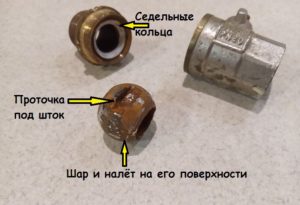
Situation:
You have not used a ball valve for a long time (at least a year). Now you have a need to either open it or close it. But ... to their surprise, they found that the handle could not be turned. It’s good if the situation is not urgent, but what if there is a leak somewhere in the system and you urgently need to turn off the water?
I'll start right away with advice on the prevention of souring of the ball valve. Make a rule for yourself: once a month, go to each ball valve and close / open it.
Why is this needed? To answer this question, I dismantled one such crane, which fell into disrepair due to prolonged inactivity.
The main element of the valve, which actually blocks the flow of liquid, is a polished ball with a through hole. In the upper part of the ball there is a groove into which a rectangular rod tip is inserted. A handle in the form of a lever or "butterfly" is fixed at the outer end of the rod.
When the ball is not moving for a long time, a coating (salt, rust ...) forms on its surface. As a rule, this situation develops on closed taps or not fully open. When you try to turn the valve, the plaque formed on the surface of the ball wedges it between the seat rings.
The ball is pressed very tightly against these gaskets and as long as it is smooth, we can easily open / shut off the water. But as soon as it becomes rough due to plaque, the process of turning the ball becomes difficult.
The photo shows just such a case. The faucet was half-open for several years. When it became necessary to block it ... I had to tinker a lot ...
Taps that are fully open are in the best position. The polished surface is located behind the PTFE (saddle) rings. There is no water and there is no plaque. However, along the narrow line of contact of the rings with the ball, a plaque is formed, at least a little. It does not wedge the crane so hard and you can still try to develop it.
Do not try to make great efforts to turn the handle! The ball is made of a relatively soft material and high force applied to the handle can cause the groove in the ball to deform under the impact of the rectangular stem tip.
If you flare this groove, the stem will no longer be able to turn the ball.
To shut off a jammed faucet, you need to remove the handle, after unscrewing the nut holding it. In most cases, there will be a nut (gland seal) under the handle. This nut must be unscrewed literally a couple of turns so that the gland seal does not interfere with the rotation of the stem.
Now the most important thing. Before starting to develop the stem, the valve needs to be heated and cooled 5-7 times. Thus, without exerting physical effort, we will stir up the stuck surfaces a little. This is best done by pouring hot water on the tap first, then cold water.
You need to turn the stem after the next treatment with hot water. The faucet body has expanded slightly, but the ball is still cold. The gap between the ball and the gasket will increase slightly and it will be easier for us to rotate the stem.
To rotate the stem, use an appropriately sized wrench. It is possible with pliers, but this way you will spoil the groove of the stem for fixing the handle.